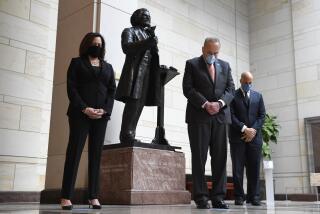Obama seeks more police training, avoids addressing Ferguson head-on
- Share via
Reporting from Washington — Ever since a Missouri grand jury decided not to indict a white police officer who killed an unarmed black man, President Obama has been under pressure to use his bully pulpit to criticize the outcome and take the lead in a national conversation about race in America.
But on Monday, he met with law enforcement officers, young activists and politicians, and mostly avoided talking publicly about the case. Instead, he focused more broadly on the tensions between police and those they’re sworn to protect, proposing a three-year, $263-million spending package to expand training and increase the use of body-worn cameras for monitoring officers’ interactions with the public.
“Ferguson laid bare a problem that is not unique to St. Louis or that area, and is not unique to our time, and that is a simmering distrust that exists between too many police departments and too many communities of color,” Obama said.
His comments came amid a debate among White House officials about whether the president should address Ferguson head-on, perhaps with a major speech on race or a trip there, advisors say. Although Obama hasn’t ruled out traveling to the town, he has concluded so far that there’s not much he can say about the shooting of Michael Brown, 18, by Officer Darren Wilson that would bridge divisions, according to a senior administration official familiar with internal discussions on the matter.
The facts in Ferguson are too disputed to address, with eyewitnesses offering divergent views about what led to the Aug. 9 shooting, according to the prevailing view among Obama’s aides.
The White House is also mindful not to appear to be meddling in a federal civil rights investigation of the shooting, nor to let Ferguson consume Obama’s agenda as he eyes the legacy-forming steps he’ll take in his final two years in office.
Obama opted for bureaucratic moves focused on law enforcement in general. As part of his broader spending plan, he proposed $75 million to outfit officers in police departments with body cameras. He also directed his staff to come up with a new executive order within four months to require additional training for local police who get military equipment from the Pentagon.
He believes that policy changes can take hold in the long run and help solve larger social problems, one aide said. Although Obama acknowledged that previous commissions and task forces have not solved the problems, this time will be different, he said, “because the president of the United States is deeply invested in making sure that this time is different.”
The policy response drew mixed reactions.
Jim Bueermann, president of the Police Foundation, a nonpartisan nonprofit that studies policing, applauded the indication that Obama’s executive order would encourage greater civilian oversight of what equipment local agencies could obtain.
Communities should have some say over whether they want bayonets, grenade launchers and armored vehicles in town, he said.
But body-worn cameras can improve police relations with their communities, he said, citing research that shows the cameras settle common disputes.
“If what we’re trying to do is increase the legitimacy of the police and the sense of confidence people have in the police and their side of the story,” Bueermann said, “then removing the obstacle to widespread adoption of body-worn cameras — the cost — is absolutely appropriate.”
Cameras have raised privacy concerns but are slowly catching on. Last month, the Los Angeles Police Department wrapped up months of testing with a decision to purchase hundreds of a model from Taser International, the company best known for stun guns. Private donors kicked in more than $1 million to help outfit the police force.
Others said Obama’s proposal was notable for showing that the White House doesn’t intend to stop providing equipment to local forces, but simply will shift more responsibility for keeping police in check to communities. Law enforcement officials in Ferguson escalated the tensions after Brown’s shooting by appearing in riot gear with assault rifles and an armored vehicle to face a crowd of peaceful protesters.
Peter Kraska, chairman of the School of Justice Studies at Eastern Kentucky University, said he’s skeptical that local leaders can rein in police practices.
“Pretending as if each locality is going to be able to police the police is exactly what got us into the problem in the first place,” he said.
Police chiefs can easily persuade local leaders to approve the acquisition of riot gear by raising the threat of a terrorist attack or school shooting, he said. And although requiring more training sounds useful, it may bring about more frequent use of the equipment and create a “warrior mentality,” he said.
Instead, the federal government should examine the culture that creates a demand for such equipment and trying to “de-emphasize the threat mentality,” he said.
Sweeping reforms might prove to be “too late for a lame-duck president with low approval ratings and a Republican majority in Congress,” said Fredrick C. Harris, a professor of political science who directs the Center on African-American Politics and Society at Columbia University.
Ferguson in many ways highlights Obama’s reluctance to wade in deeply on issues of race and the law. To this day, White House debate is influenced by the backlash that followed Obama’s 2009 comments on the arrest of black scholar Henry Louis Gates Jr., when the president said police “acted stupidly.” And Obama’s remark that a son of his would look a lot like Trayvon Martin appeared to help polarize the conversation over the teenager’s shooting death in 2012.
Despite Obama’s care to avoid a full-on racial debate, it cropped up anyway Monday. In his conversation with community leaders, there were some working assumptions that irritated police representatives who attended.
“Clearly the focus there was the assertion that there is intrinsic bias in policing in many communities of color,” said Jim Pasco, executive director of the national Fraternal Order of Police. “While we do not agree that there is a systemic problem, we would certainly agree that there is a very serious perception there and it’s something that needs to be addressed both for the peace of mind of residents of those communities and to enhance public safety.”
Times staff writers Joel Rubin and Cindy Chang in Los Angeles contributed to this report.For more White House coverage, follow @cparsons.
More to Read
Sign up for Essential California
The most important California stories and recommendations in your inbox every morning.
You may occasionally receive promotional content from the Los Angeles Times.















